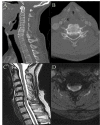A Retrospective Pilot Study for Preoperative Screening to Prevent Iatrogenic Cervical Spinal Cord Injury
- PMID: 33564543
- PMCID: PMC7863023
- DOI: 10.7759/cureus.12550
A Retrospective Pilot Study for Preoperative Screening to Prevent Iatrogenic Cervical Spinal Cord Injury
Abstract
Purpose: The preoperative medical clearance process is well established to screen for medical comorbidities and therefore must be thorough. However, screening for potential cervical spine disease is often overlooked. In older surgical candidates, the presence of cervical spondylosis can increase risk of iatrogenic cervical spine injury during prolonged neck extension in non-spinal surgeries. We present a standard protocol for cervical spine clearance and a novel sustained neck extension maneuver through a retrospective case series.
Methods: Sixty-three consecutive cases that underwent preoperative cervical clearance between April 2012 and December 2019 were reviewed. Referral for clearance occurred through the department of anesthesiology after concerning radiographic or physical exam findings were noted. A standard preoperative screening protocol with a sustained one-minute neck extension maneuver was implemented. Recommendations were made for standard neck precautions with or without neuromonitoring or for cervical spine decompression surgery prior to the planned procedure.
Results: There were 25 patients with symptoms of myelopathy, 11 with radiculopathy and 13 with neck pain at baseline. Cervical spondylosis was observed in 51 patients, cervical canal stenosis in 29 and cervical myelomalacia in six. Fifty-seven patients underwent neck extension exam and 25 exhibited new or worsening symptoms. Myelopathic symptoms and radicular pain at baseline and positive Hoffman's and Spurling's sign, independently, were significantly associated with a positive neck extension exam (p<0.05). Fourteen patients were recommended for cervical decompression prior to planned procedure.
Conclusions: Our preoperative cervical spine clearance protocol is safe and may aid in identifying patients susceptible to iatrogenic cervical spine injury.
Keywords: central cord syndrome; cervical hyperextension; cervical spine injury; iatrogenic; preoperative clearance.
Copyright © 2021, Diaz et al.
Conflict of interest statement
The authors have declared that no competing interests exist.
Figures




References
-
- Validation of a pre-anaesthetic screening questionnaire. Hilditch WG, Asbury AJ, Jack E, McGrane S. Anaesthesia. 2003;58:874–877. - PubMed
-
- 2014 ACC/AHA guideline on perioperative cardiovascular evaluation and management of patients undergoing noncardiac surgery: a report of the American College of Cardiology/American Heart Association Task Force on practice guidelines. Fleisher LA, Fleischmann KE, Auerbach AD, et al. J Am Coll Cardiol. 2014;64:77–137. - PubMed
-
- Effect of obesity on early morbidity and mortality following cardiac surgery. Yap CH, Zimmet A, Mohajeri M, Yii M. Heart Lung Circ. 2007;16:31–36. - PubMed
-
- Smoking and alcohol intervention before surgery: evidence for best practice. Tønnesen H, Nielsen PR, Lauritzen JB, Møller AM. Br J Anaesth. 2009;102:297–306. - PubMed
-
- Improving the detection of illicit substance use in preoperative anesthesiological assessment. Kleinwachter R, Kork F, Weiss-Gerlach E, et al. https://www.minervamedica.it/en/journals/minerva-anestesiologica/article.... Minerva Anestesiol. 2010;76:29–37. - PubMed
LinkOut - more resources
Full Text Sources
Other Literature Sources
Miscellaneous
